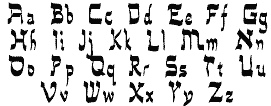


#English hebrew font install
On the File menu, click Install New Font.Type the following command, and then click OK: %windir%\fonts.Drag the font file into the Font folder.Hebron Hebrew is a font that contains the 22 Hebrew letters along with the five final letters that are automatically activated when used in Applications like Apples Pages and MicroSofts Word. 1609 search results (0.012 seconds) Hebron Hebrew by Jonahfonts 35.00 USD.
#English hebrew font download
Open a file explorer window with the font file stam+hebrew - abstract fonts - download free fonts.Search for Control Panel > Appearance and Personalization.Right-click on the font file and select "Open".The originally downloaded file can be deleted.The problem with the font (s) Im using currently (calibri for english, frank ruehl for hebrew) is that the transition from English to Hebrew isnt smooth, its jarring when the eyes of the reader go from the left-to-right English to the right-to-left Hebrew, and it ruins the immersion. msi which will automatically install the font for you There is a lot of Hebrew mixed in with the English. Many font packages will come with a a file called setup.exe or file ending with.This expansion has been regarded extensively around the world, and can be seen on various online typographic services such as, open-source font libraries such as Google Font Library, and throughout the vast range of state-of-the-art typography growing on and for the web. These new standards opened a wide range of possibilities for web developers, designers and end-users, allowing them to expand the use of web-fonts beyond the proprietary selection of fonts embedded in operating systems. allows emebbing of any font to a web page, similar to they way images are embedded. Over the past year (since the release of the Firefox 3.6 browser) since the implementation of the standard in all of the popular browsers. Moreover, the design for the Hebrew version of Arial was inspired by the font "Narkis Neue" as an attempt to serve as an equivalent to the Latin version of Arial, which was developed itself as a poor interpretation of the modern san-serif font "Helvetica". Times with no choice but to use Arial as their default font, limiting designers and various digital needs. Despite the great potential, this reality has left designers many

While in Europe and the USA web-fonts have been in development for years, the variety in Hebrew remains very limited. All this is almost completely neglected when designing web-fonts in the Hebrew language. Producing a clear and legible text for the screen is a result of multiple parameters, including the design of the characters themselves, their structure, various sequences, and most importantly, their appearance in small sizes for digital display. There is no doubt that globalization and the dominance of English online inevitably takes a dominant part of our internet experience, however, there are other aspects to this issue that we are able to address and perhaps even have an influence on. Many Israeli websites are designed in English and don't even bother including a Hebrew version, not to mention apps and mobile devices where Hebrew is scarcely seen. Over the past few years, English has become the preferred online language, even by Hebrew speakers.


 0 kommentar(er)
0 kommentar(er)
